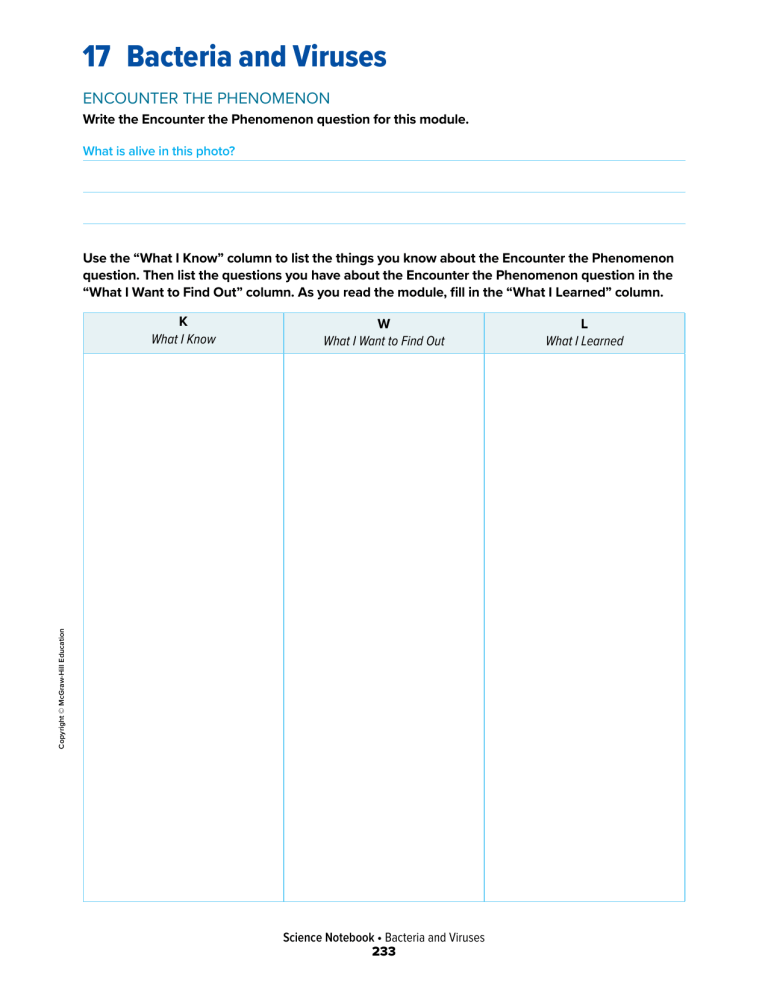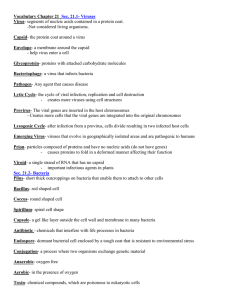
17 Bacteria and Viruses ENCOUNTER THE PHENOMENON Write the Encounter the Phenomenon question for this module. What is alive in this photo? Use the “What I Know” column to list the things you know about the Encounter the Phenomenon question. Then list the questions you have about the Encounter the Phenomenon question in the “What I Want to Find Out” column. As you read the module, fill in the “What I Learned” column. W What I Want to Find Out Copyright © McGraw-Hill Education K What I Know Science Notebook • Bacteria and Viruses 233 L What I Learned Bacteria and Viruses 1 Bacteria REVIEW VOCABULARY prokaryotic cell Recall the definition of the Review Vocabulary term. prokaryotic cell cell that does not contain any membrane-bound organelles NEW VOCABULARY Use your book to define each term. bacteria bacteria prokaryote that has peptidoglycan in its cell wall nucleoid circular area of a prokaryotic cell that holds the chromosome capsule layer of secreted polysaccharides around a prokaryotic cell wall nucleoid capsule pilus binary fission pilus conjugation the outer surface of some prokaryotes; used in attachment endospore binary fission submicroscopic, hairlike structure made of protein that is found on conjugation division of a cell into two genetically identical cells method of reproduction in which two prokaryotes attach to each other and exchange genetic information endospore structure produced by some bacteria during harsh environmental conditions that contains genetic information and can germinate into a new bacterial cell when conditions improve 1. hot, acidic: sulfur hot springs, thermal vents, volcanoes 2. high concentrations of salt: Great Salt Lake, Dead Sea 3. oxygen-free: swamps, bogs, volcanic vents Model a prokaryotic cell and label its structures. Drawings should include all labels shown in Figure 3. Accept all reasonable variations. Science Notebook • Bacteria and Viruses 234 Copyright © McGraw-Hill Education Summarize three general environments where archaea live, and give one example of each environment. 1 Bacteria (continued) Get It? flagella. Explain the difference between prokaryotic and eukaryotic Prokaryotic flagella are made of filaments, unlike the flagella of eukaryotes, which are made of microtubules. Identify each prokaryote shape below with its scientific name. Cocci Bacilli Spirilla Compare prokaryote reproduction by completing the table below. Reproduction Method Copyright © McGraw-Hill Education Process Binary Fission Conjugation chromosome replicates, two individuals use cell elongates, new pili to attach to each piece of plasma other and exchange membrane and cell wall genetic material forms and separates cell Result two genetically new gene combination identical cells Compare prokaryotes by describing how each group below obtains energy for cellular respiration. Saprotrophs: decompose dead organisms or organic waste Photoautotrophs: use light for photosynthesis Chemoautotrophs: break down inorganic compounds that contain nitrogen or sulfur; process is called chemosynthesis Science Notebook • Bacteria and Viruses 235 1 Bacteria (continued) Get It? Summarize the importance of photosynthesis and cellular metabolism in bacterial metabolism. Photosynthesis and cellular metabolism are the basis for bacterial metabolism. However, some bacteria are also chemoautotrophic. They synthesize organic molecules without photosynthesis. Identify two bacterial survival mechanisms and describe the advantages of each mechanism. Mechanism Endospores Survival Advantages can survive extreme conditions that kill the bacteria; germinate when conditions improve produce new gene forms and combinations; Mutations increase chances that some can survive environmental changes and repopulate Get It? Explain how mutations can help a population of bacteria develop new adaptations in response to a change in the environment. Mutations lead to new forms of genes, new gene combinations, new characteristics, new adaptations, and genetic diversity. When the distribution of traits in the population of bacteria changes, the bacteria List five ways that bacteria are helpful to humans. decompose dead organisms and recycle nutrients Bacteria are helpful nitrogen fixation normal flora protect against disease and produce vitamin K used in producing foods and vitamin pills used in producing antibiotics Science Notebook • Bacteria and Viruses 236 Copyright © McGraw-Hill Education have adapted to the new environment. 1 Bacteria (continued) CHECK YOUR PROGRESS 1. Diagram a bacterium. Diagrams should include representations of the cell wall, chromosome, pili, and capsule. 2. Discuss possible rationales that taxonomists might have used when deciding to group prokaryotes into two distinct domains instead of in one group. The two groups have different biochemical and genetic components and they live in different environments. 3. Explain survival mechanisms of bacteria at both the individual and population levels. Individually, bacteria form endospores that are resistant to harsh environments. Random genetic mutations allow bacteria as a population to adapt to new conditions. Copyright © McGraw-Hill Education 4. List three ways bacteria are beneficial to humans. Bacteria recycle nutrients in an ecosystem. E. coli produces vitamin K. Some bacteria are used to make antibiotics or other medicines. 5. Analyze why it is more difficult for biologists to understand the diversity in prokaryotes as compared to plants or animals. The diversity in prokaryotes exists on the cellular level and is not visible to the naked eye. 6. Imagine that today at 1 P.M., a single Salmonella bacterial cell landed on potato salad sitting on your kitchen counter. Assuming optimal conditions for bacterial growth, how many bacterial cells will be present at 3 P.M. today? 64 Science Notebook • Bacteria and Viruses 237 Bacteria and Viruses 2 Viruses and Prions REVIEW VOCABULARY protein NEW VOCABULARY virus capsid lytic cycle lysogenic cycle retrovirus prion Recall the definition of the Review Vocabulary term. protein large, complex polymer composed of carbon, hydrogen, oxygen, nitrogen, and sometimes sulfur Use the new vocabulary terms in the left column to complete the following paragraph. virus A is genetic material within a protein coat, but it has no organelles or other characteristics of life. The genetic capsid material lies inside its , or outer layer of protein. In the lytic cycle viral genes instruct the host cell to make many copies of the viral RNA or DNA. Some viruses replicate in a lysogenic cycle , in which the viral DNA integrates into a host chromosome and lies dormant for some time. A retrovirus , such as the HIV virus, contains RNA instead of DNA. Mutation in the genes of a normal protein called a prion is responsible for diseases such as “mad cow.” ACADEMIC VOCABULARY widespread Define widespread to show its scientific meaning. widely diffused or prevalent Copyright © McGraw-Hill Education Science Notebook • Bacteria and Viruses 238 2 Viruses and Prions (continued) Sketch t he general structure of a virus. Sketches should show nucleic acids, DNA, or RNA in its core, and an outer protein coat. Synthesize why many viruses cannot pass from one species to another. The virus attaches to the host cell using specific receptors on the plasma membrane of the host. Different types of organisms have receptors for different types of viruses, limiting transmission between species. Label steps A, B, C, D, and E of a lytic cycle in the figure below. Use the following terms. • Assembly •Attachment • Lysis and Release • Replication Bacteriophage Nucleic acid • Entry Bacterial DNA Bacterial host cell Copyright © McGraw-Hill Education A Attachment B Entry The bacteriophage injects its nucleic acid into the bacterial cell. E Lysis and Release The host cell breaks open and releases new virus particles. C D Assembly New virus particles are assembled. Science Notebook • Bacteria and Viruses 239 C18-05C-873043-BO-A Replication The host’s metabolic machinery makes viral nucleic acid and proteins. 2 Viruses and Prions (continued) Sequence the steps of a lysogenic cycle. Viral DNA integrates into a chromosome of a host cell. There the viral genes remain dormant for months or years. Activation triggers the lytic cycle to begin. New viruses leave the cell by exocytosis or by bursting the cell. Evaluate and discuss the role of reverse transcriptase in the replication cycle of HIV. After HIV attaches to a cell and releases its RNA, the reverse transcriptase enzyme synthesizes DNA using the viral RNA as a template. Summarize information about prions by completing the table. What causes a prion to become harmful? It mutates. How might humans contract a prion-caused disease? by eating beef from an infected cow What is the result of prion infection? Prions infect nerve cells in the brain, causing them to burst. SUMMARIZE Conclude whether viruses that replicate by the lytic cycle or the lysogenic cycle are more dangerous. Explain your reasoning. Accept all reasonable responses. Science Notebook • Bacteria and Viruses 240 Copyright © McGraw-Hill Education What is a prion? a protein that normally exists in cells but can cause infection or disease 2 Viruses and Prions (continued) CHECK YOUR PROGRESS 1. Describe how viruses and prions can alter cell functions. Viruses cause an infected cell to make more viruses; prions cause proteins inside cells to mutate and change shape and function incorrectly. 2. Compare and contrast similarities and differences in the replication of a herpes simplex virus with a human immunodeficiency virus. Herpes viruses have DNA; HIV has RNA. HIV contains reverse transcriptase. Replication is similar in that genetic material from both enters the host cell nucleus. 3. Draw a diagram of a virus and label the parts. Students should provide a diagram similar to Figure 11. 4. Sequence the steps in the process of how prions might be transmitted from cattle to humans. Possible answer: (1) The cattle-butchering process releases prions into the meat. (2) Humans Copyright © McGraw-Hill Education consume the infected meat. (3) Prions travel to the brain. 5. Propose ideas for the development of drugs that could stop viral replication cycles. prevent a virus from attaching to host cells; disrupt the viral replication process; prevent the final assembly of new viral particles 6. Write a paragraph explaining why it is difficult to make drugs or vaccines that effectively fight against HIV, given the fact that each time reverse transcriptase works, it makes a slight miscopy. Paragraphs should indicate that each time HIV replicates, a slightly different type of the virus forms, so drugs or vaccines might be ineffective. Science Notebook • Bacteria and Viruses 241






